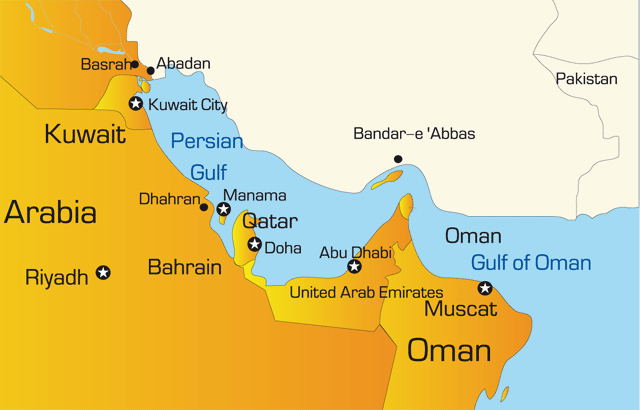Iran's gas export projects to Persian Gulf countries
With 12 percent growth in gas production levels during 2014 and the same projected volume for 2015, Iran is testing the water to choose its gas export routes based on priorities.
The country produces 660 million cubic meters per day (mcm/d) of enriched gas and the volume is expected to increase by 100 mcm/d by March 2016.
The managing director of the National Iranian Gas Export Company (NIGEC) Alireza Kameli says the country's priority for gas export is neighboring states in the Persian Gulf, (also known as the Arabian Gulf).
Shana quoted Kameli on Feb.3 as saying that for exporting gas, there is need only of a 200-km long under-water pipeline through the Gulf. He named Iraq, Oman, Bahrain, Saudi Arabia, United Arab Emirate and possibly Kuwait as potential customers.
He underlined that Iran started negotiations with some of them. Tehran has signed gas memorandum of understanding (MoU) with Oman to export 30 mcm/a of gas to this country by 2016.
Iran has five major cross-country pipeline projects, of which four -worth $13.7 billion- are aimed towards gas export to Pakistan, Iraq, Turkey and Oman.
Iraq:
Iran's first priority is delivering gas to Iraq via two separated routes. Iran wants to deliver gas from Tang Bijar gas field in Ilam province's Naftshahr towards Iraqi’s capital, Baghdad.
Currently Iran produces 7 mcm/d of natural gas from this field and wants to start gas export to Iraq by February 2015 in restricted amount at 4 mcm/d. The final gas delivery capacity from this rout would reach 25 mcm/d.
However, Iran's major target is exporting the gas of giant South Pars. The second target is Iraq's Basrah region. The Iranian side of this route is expected to cost $1.5 million.
For realization of these two projects, Iran should complete the sixth cross-country pipeline.
This pipeline has been completed by 611 km starting from South Pars and is to eventually reach the Iraqi Kurdistan border. Some $2 billion is needed to complete this pipeline with 110 mcm/d transition capacity.
Iraq needs Iranian gas to use in its power plants. The country's gas reserves are about 3.6 trillion cubic meters, about 10 times less than Iran. About three-fourths of Iraq's natural gas reserves are associated with oil. Currently Iraq produces only 0.6 bcm/a of refined gas.
Iraqi gross natural gas production was about 20 bcm in 2012, of which 12 bcm (58 percent) was vented and flared. Natural gas that is not flared is mostly used for re-injection into oil wells to increase oil recovery rates.
Oman:
Tehran sealed a deal with Muscat to export 30 mcm/d of natural gas on March 12,2013. The cost of construction a 200-km underwater pipeline from Iran to Oman is estimated be at $ 1 billion. The sides agreed that gas deal be commenced in 2016.
Oman's gas reserves roughly reach 0.9 tcm. The country's yearly gas production is about 85 mcm/d, while consumption level in 2013 was 39.1 mcm/d, indicates a 3.2 percent increase compared to 2012.
Oman has about 5 to 7 mcm/d of gas import through its Dolphin system, while the country exports about 10.4 million tons of LNG per year, equals to about 39 mcm/d.
The country's gas injection to oilfield was also about 9.047 mcm/d in 2013, indicates 4.9 percent increase compared to the previous year, H E Salim al Aufi, Undersecretary at the Ministry of Oil and Gas, said in February 2013.
Until now, Oman hasn't had any serious gas shortage problem, but the high rate of gas consumption growth may endanger the country's energy security in upcoming years.
The rising consumption prompted Oman LNG to announce it would divert all of its currently exported volumes of LNG away from foreign markets and toward domestic consumers by 2024, the U.S. Energy Information Administration reported in October 2013.
Several years ago, Oman signed a production-sharing agreement with BP for the development of the Khazzan gas field in Block 61, aimed at drilling 300 wells over 15 years to produce 28.3 mcm/d of gas.
However, regarding the high consumption growth, which increased from 5.5 bcm in 2002 to above 17 bcm in 2013, the signing of a gas deal with Iran will strengthen Muscat's energy security as well as gas import resource diversification.
Saudi Arabia, Bahrain and Kuwait:
Because of disputes between Iran, Bahrain and Saudi Arabia, it doesn't seem that any gas deal will be sealed between Iran and these countries, but Kuwait has a quite good market for Iranian gas. In all of these countryies, gas production relies mostly on associated gas and needs a huge amount of gas to re-inject into oil fields like Iraq.
Kuwait's total gas reserves stands at 1.6 tcm and production volume is 15.6 bcm/a.
Kuwait is a net importer of gas, consuming above 17.8 bcm/a of natural gas. Kuwait imports LNG, but regarding the need for more gas for power plants during summers, Iran can see this country as a restricted gas market. Currently Kuwait needs a little more than 2 bcm/a of gas imports.
Iran also has a contract with Pakistan to export about 8 bcm/a of gas initially until January 2015. However, Pakistan hasn't started the construction of a pipeline inside its territory yet.
Pakistan recently said the pipeline would be completed in three years. The Iranian side also needs about $700 million to complete the remained 300-km pipeline in two years.
Currently, Iran exports 10 bcm/a of gas to Turkey and imports the same value from Turkmenistan.


Comments
Post a Comment